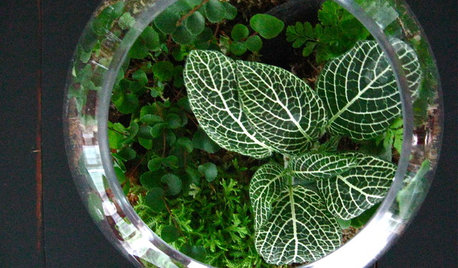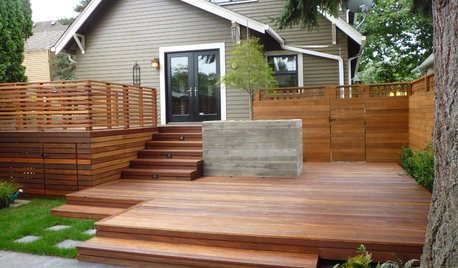Black Plastic Under Mulch--Yes or No?
In Virginia, I put down thick black plastic sheeting to cover an entire bed, cut holes in the plastic wherever I wanted to plant something, covered the plastic with mulch and then just watered occasionally through the holes. I also had a soaker hose beneath the plastic in one bed which worked well. The plastic held in moisture and controlled weeds. Does that work here, or would it get too hot under the plastic and kill the plants?
Comments (39)
sandradee
16 years agoI'm impressed. I've never managed to do the black plastic thing very well...always ended up torn or shredded due to changing my plants or getting too vigorous in fluffing the mulch. Then I'd have these shredded plastic streamers sticking up through my mulch, wafting in the breeze...what a look!...ought to be featured in a gardening magazine. LOL!!
I've had much better success in using that gray landscaper's fabric. Although it's more pricey, it's less prone to damage from my mishandling it. When it does disintegrate, it's a little more environmentally friendly.
I think others have been using cardboard with pretty good success.
Sandy
chena
16 years agoHey!!
Black plastic when it dies it doesn't go anywhere ..You will be left with the mess...If you are looking for weed block you can use cardboard in the same fashion but it well eventally go away and is earth friendly.. Newspaper as well just doesn't last as long and a booger to fight in the wind..LOL
Chena...Related Professionals
Cary Landscape Architects & Landscape Designers · Biloxi Landscape Contractors · Deerfield Beach Landscape Contractors · Elmhurst Landscape Contractors · Fort Myers Landscape Contractors · Fort Wayne Landscape Contractors · La Verne Landscape Contractors · San Carlos Park Landscape Contractors · North Hills Landscape Contractors · Columbia Window Contractors · Spokane Window Contractors · Deltona Window Contractors · Hawaiian Gardens Window Contractors · Hesperia Window Contractors · Fairland Window Contractorsaus_tx
16 years agoI used the exact same method for my vegetable garden last year here in austin. It worked really great for me. Last year was hot and dry. Even In peak summer, I was watering every other day. I used that black plastic from walmart. I am going to do the same thing this year.
TxMarti
16 years agoLOL txgardenlady, I was going to say the same thing. I use throw rugs that have lost their rubber backing. Nice size to work with. I also just use them without mulch to kill off weeds before planting.
bo_berrin
Original Author16 years agoThanks for all the great info. It's good to know I can still use that method when I need it.
I'm really curious about the rugs/cardboard idea.
Concerning rugs--I'm assuming you just use this between plants, right? Or do you cut a planting hole in them like one would with the plastic/fabric, and plant *through* them? Using them makes sense because the water would seep through but the weeds couldn't grow.
Concerning cardboard--is this what they call lasagna gardening or is that more involved? Laying cardboard on the bed and covering with mulch sounds so simple and inexpensive, which is my kinda method! Is it easy to cut through later to add another plant? I want my plants to be able to spread, and plastic would prohibit that--would the cardboard method solve that problem?
Chena, I hadn't thought about the environment--duh. That definitely makes it worth spending the few extra dollars on the landscaper fabric. I'm trying to be more earth-friendly, but sometimes things just don't occur to me until someone mentions it. Thanks for the reminder!
natvtxn
16 years ago"is this what they call lasagna gardening"
Yes, put the mulch over the cardboard and it will eventually decompose. You can cut through it to plant.
I use roofing paper under the mulch.
I was told not to use black plastic,as it conducts the heat and will "cook" the roots of plants.
beachplant
16 years agoAnd then it will break up and you'll be pulling pieces of black plastic up for the rest of your life.
I use newspaper and junk mail under the mulch, sometimes. I don't mulch much, except the pathways, if there is room for a weed there is room for a plant.
Tally HO!carrie751
16 years agoYou are so right, Tally. I am still pulling black plastic put down over 12 years ago. I will NEVER do that again.
momofjandj
16 years agoI've read and heard the same about not using plastic...it gets too hot and cooks the roots. Plus, who wants to be pulling plastic pieces for the next 12 years?! lol
cncnorman
16 years agoFor the love of everything that is good and green do not fall into that black plastic trap. My parents used it at their house over twenty years ago and I can still dig into the garden and pull up shreds of that junk. I shred all the credit card offers that come to the house and old school papers from my kids, and catalogs and magazine advertisements. I use this for mulch and so far I really seem to like it. Kinda looks like a snowman puked in the garden and DH would be really happy if I would add something wood looking on top but I like the snow look. :) Makes me think cooler - LOL!
Christinacweathersby
16 years agoI've tried both the black plastic and the landscape fabric. Neither worked. And it's hard to get it out once the weeds have grown on top of the landscape fabric. Actually it's still out there somewhere ... I even put the soaker hoses underneath the plastic just like you did! It amazes me that it worked for you before, because mine just ripped and the weeds grew and took over the bed.
I use the cardboard method with great success. Make sure the grass is dead before adding cardboard if you are making a new flower bed. We're talking multiple rounds with Round Up leaving enough time between the rounds for the grass to grow back if it's still alive. Otherwise a lot of it will just grow right through. My 1st rose garden was done right, with 3 rounds with Round Up, each one 2 weeks apart. There are still no weeds 2 1/2 years later. My 2nd rose garden was made this winter. The grass wasn't growing because it was cold outside so I thought I could just add the cardboard, compost, cardboard, mulch layers like I did in the 1st rose garden and that since the grass couldn't get any light then it wouldn't grow in the spring. Boy was I wrong. And it is so expensive to fix a big mistake like that. There is grass everywhere but I can't spray Round Up because it would kill my roses so I'm having to spray Grass Killer which is much more expensive and doesn't work very quickly. Also, I may kill 1 grass but 5 more spring up every time it rains.
Bottom line - don't forget to kill the grass first!If you decide to go with cardboard, be prepared to be amazed at all of the earthworms you will have!! It's an instant effect, too. I dug into a bed that was made this Feb and it was chock full of earthworms already.
kinglerch
16 years agoBlack plastic is only good for a short period of time, after that it gets brittle and rips. The problem is that I have a large area (25'x80') and I can't find anything anywhere near that big.
Landscape fabric only comes in 3' widths, so I would need 8 strips, which would be tough. It's too big for regular mulch. And I haven't seen cardboard rolls that are very wide either, do you know where I could find some?
I'm happy to try anything as the weeds here are awful. But I'd like something I can cover this area with less than 5 pieces, hopefully 2 or 3. The more pieces, the more chance for weeds and blowing wind to take everything apart.
Other suggestions?
lyfia
16 years agokinglerch - At my old house I used landscape fabric that was 6' in width. It was double folded on a 3' roll and I think I got it at HD or Lowe's. I used stakes in the corners to hold it down and it did very well and overlapped where needed and had no weeding for the last 3 years I lived there, but too much the years before I did it.
kinglerch
15 years agoI have done a little more testing on this. My feeling is that black plastic is a poor option, not because of how it works (water, air, heat) but it seems a poor choice for longevity. I tried a rather thick 4 mil plastic, and within a year it tore, cracked, broke apart, etc. When it is full of debris, it is unbearably heavy. Trying to move it tore it again and again.
Landscape fabric is probably the best choice since it seems to last a long time for me (I guess you can buy it in different thicknesses too) it is very lightweight, easy to cut, and can keep weeds out under mulch. I use it wherever I can, like under trees. However, it only comes in relatively thin strips (3'-6').
There are also other "landscape fabrics" or "ground covers" that are similar, but come in 12' widths, which would still work ok for me. They tend to be a bit on the expensive side, but I would still buy them if they would last.
The option I am trying now has been working great (so far), is comparitively cheap, and comes in almost any size and color. I have been using 10mil woven tarps, they also come thicker. They are designed to cover cars or trucks. I am using two 25'x80' black/green with tiedowns around the edge. These tiedowns attach to my fence and keep it in place. I can then cut holes to plant, and due to the weave I haven't yet (knock on wood) had any cracks or rips. I have even stood on tight areas and accidentally loosened the tiedown, but there were no breaks or holes created.
It is also extremely lightweight. A decent wind blows under, so I don't worry too much about smothering the ground. And it's relatively easy to move around despite the huge size.
I did notice some significant shrinking in the sun, probably about a foot has disappeared. I will also concede that I have only used it for a month or so. Time out in the heavy sun will tell just how durable it will be. But if the last month is any indication, this could be a nice alternative to plastic.
FWIW
fool4flowers
15 years agoHubby used an old tarp to bring home a load of mulch thinking he could pull it out of the back of the truck once we shoveled most of it out and I have little shredded blue things sticking out all over my flower bed where it tore, lol. The carpet under the fence is a great idea. I have one side of my fence chainlink and the neighbor has a privacy fence up and I hate the grass growing between them. Maybe I could lift it up and put the carpet and mulch to keep it from growing back. Thanks for the idea.
dahlia_newbie
15 years agoWelcome to Texas, Bo! I hope your Texas gardening is a great success.
I say NO NO NO to the black plastic. Ten years after putting mine in, parts of it are now "anchored" to the ground with the roots of persistent weeds. I didn't do the soaker hose, though. I thought I had seen the last of the stuff last year when I redid a whole bed and pulled out giant sheets of the stuff, but no, still pulling pieces out this year...Great fun. I'm in agreement with Tally's theory...just crowd the weeds out with perennials, I say! Haha. When my husband says I already have enough plants, I remind him that "I can still see spots of dirt large enough to fit these new ones into...and they were on sale honey!"
I like the shredded junk mail thing...hadn't tried that...I've been mailing all my junkmail to random credit card companies using their postage prepaid envelopes...I guess using it for mulch would be a lot more "zen".
I don't use anything now. I am resigned to weeding every weekend. it relaxes me. I get cranky when I don't get my dirt manicure. For me, it's mulch, water, weed, repeat.
kinglerch
15 years agoMy point was that the concept of black plastic is not bad (keep weeds out, moisture in) but it doesn't last...in a bad way. It shreds, but stays around in one useless form or another.
Shredded paper / cardboard doesn't last in a good way. It stays for a few months, then degrades into the soil. If you need a temporary mulch, it could work well. For a large garden that is around for 6 months, it just isn't practical.
The large woven tarp was the cheap, light but thick, lasting (hopefully) solution for me. Time will tell.
linda_tx8
15 years agoIf anyone feels they have to use the weed-blocking landscape fabric, ask the nursery people. There is some more sturdy kind that comes on large wide rolls and you can buy it by the foot or yard. I've only got some under a peach tree and covered with lots of mulch, which I add more when the mulch breaks down. It's better than the cheaper stuff. But other than that one place, I avoid it.
patty_cakes
15 years agoI've used black plastic in the past, but really like the idea of the cardboard. I always try to make whatever contribution I can to be environmentally friendly.
Since i'll be making the move to TX next month, i'll be saving all my boxes! ;o)pricklypearsatx
15 years agoTo black plastic: NO NO NO
Heavy Duty Landscape Fabrics: On paths only
Landscape fabrics in beds: Use only during the first season while getting bed established. Can be placed on top of a lasagne bed and covered with thin layer of shredded mulch. Remove after the first season, or it will become a mess.
bhhstudios
15 years agoI just wanted to let everyone know that there is a 100% Biodegradable & certified organic! product that works just as well as the plastic but starts to break down before the growing season is over, once the plants are able to provide shade and no longer need a weed barrier.
No this is not like the actual plastic that just breaks down to small pieces, it is made of plant matter and just gets composted at the end of the season.
Here is a link to the product: http://www.leevalley.com/garden/page.aspx?c=1&p=47493&cat=2,2300,33272
Hope this helps some people.
kinglerch
15 years agoWell, it has been a year for my tarp experiment and it worked great. I have a large garden (25' x 90') and a rediculous amount of weeds (look around the edges!) The weeds assult anything I plant in a matter of weeks.
I tried black plastic, but it got too brittle and tears into shreds. Cardboard only lasts a few months, then turns to mush. Regular landscape fabric is good, but it does allow some creative weeds to grow right through it, and it would take too many strips to fit a 25' x 90' area.
What I tried last year were two 25' x 40' heavy duty tarps, the kind used to cover trucks or something. I layed out soaker hoses, covered with the tarps, and cut holes where I planted.
The biggest problem with my idea was that no matter how hard you try, the wind gets under the tarp and shifts it around. This would sometimes decapitate the younger plants as the holes blew around with the wind. It also required placing wood planks or bricks around to keep the tarp from blowing away like the sail on a sailboat.
But after the plants took hold, the tarp perfomed great. I had very little or no weeds, and the tarp held up for the entire year with no significant damage. There was one area that looked like it was attacked at the seam by an animal, but that was it.
The tarp idea is not for everyone, but for large weedy areas, this was the least work and cheapest solution for me.
Here is a link that might be useful:

lvcntrylife
15 years agoI've made a triangle area with huge boulder rocks in it and plan on just having a water feature in the middle, no plants or flowers. My husband laid our old pool cover on the ground (it's heavy black plastic) then placed the boulders. Will I still have weeds coming through it? I've tried the fabric stuff before in my other gardens and weeds took over before I could get control of them. I don't want ANY weeds! Help!
annnorthtexas
15 years agolvnctrylife, you should be okay for some time with the pool tarp. I use mine to kill weeds/grasses. But then it gets pulled off and put back in storage when I'm not using it. Not sure how long it would last in the open year round.
bobbi_p
15 years agoI don't want to point out the obvious, but:
Once your mulch on top of whatever weed barrier you might choose to use begins to decompose, you have an organic layer in which weed seeds that drift in and grass that creeps in can take root and grow. The undesirables you're trying to deal with initially are just replaced by others with different means! When I add more mulch/compost to an area, I always weed first, add newspapers 3-4 pages thick, then top with my new compost/mulch.
As much as many of us would never like to pull another weed in our life, there's no getting around it. My experience at my old place with the landscaper cloth was that Bermuda grass creeped in over the top and was able to weave its roots through the cloth just enough to make pulling it impossible without ripping up the whole shebang. I agree with Dahlia newbie that we should just plant more ornamentals to crowd out the weeds!
I couldn't get Kinglerch's picture to come, but was wondering if his large area was for vegetables or what? I'm curious to see his project, but the link wouldn't work for me. My one thought on that matter, if it is for vegetables, is that crop rotation is highly recommended for various vegetable families to reduce pest/disease problems. I wouldn't like to plant in the same holes every season if it is, indeed, for vegetables.
As far as black plastic, aside from it's obvious non-decomposing trait, I don't think it's so much a problem that it gets "hot" and "cooks" the roots per se, but maybe more so that they can't "breath." Plants, even roots, and the beneficial bugs below need air to do their jobs properly and plastic of any color suffocates what's below!
Just my 2 cents! Looks like we all agree not to use black plastic anywhere we want to plant!
kinglerch
14 years agoI fixed the link (I hope) so you can try it again.
Yes, the garden is for vegetables. I cut holes in it to allow most of the plants to breath, and there are soaker hoses below to get everything water. Also, the tarp prevents much of the evaporation, so less water is necessary. I can also rotate or swap the tarps to move the crops.
But of course there are some downsides. The tarp gets a lot of wind underneath, and can damage the plants when they are little. The tarp can prevent some water from getting in and prevent some breathing of the soil. And there was some rodent damage to the tarps, so I assume they will need replacing in 3-5 years or so.
But the weeds here are uncontrollable. My garden is too big and the weeds too envasive. I have no choice but to put some weed barrier. This one is the one that worked best for me.
Another option is to get what they call woven 'groundcovers'. They do let more air and water in/out of the garden, and they come in 12' rolls. But with air/water come a few weeds too, and of course they are more expensive than tarps, so YMMV.
bobbi_p
14 years agoWow, who could argue with that Kinglerch?
Gorgeous garden. Where in this state, pray tell, do you live?
PS I had to look up "YMMV" in the "urban dictionary." I'm not that hip yet! (For the rest of you who might not know: Your Mileage May Vary.
kinglerch
14 years agoI am in cleveland, so in addition to dealing with weeds, I have a very short growing season. I have to try and get the most out garden before everything is destroyed with just one early frost.
The funniest thing about my photo is that you can see the thick weeds all around the perimeter. You can just hear them saying "let me in!" but the tarp keeps them (mostly) out.
joie33
14 years agoI go the newspaper (weighed down by shredded wood mulch) as weed barrier route myself. I have plenty of it. It decomposes eventually.
Whatever weeds pop up afterward are just allowance opportunities for my industrious nieces and nephews. :-)
kinglerch
14 years agoJust to post an update, I bought a 25x40 10 mil tarp "12x14 weave" (whatever that means) and after 2 years, it is just starting to weaken. The tarps are outside all year, because it is too much effort to take the whole thing down in the winter...although I'm sure the sun damage is worst in the summer.
Anyway, I think I'll get just 1 more, maybe 2 years max out of these tarps. That would match the 3-5 years I was expecting, but maybe I can find something better.
Note that a major factor in the tarps lasting is the construction, not just the thickness. I have the added issue of animal attacks (moles, I think) so that never helps.
Will keep adding if I learn anything new.
gblack
13 years agokinglerch
Your tarp idea is interesting.
What did you use to secure the tarp with?
Did you bury the outside edges of the tarp?
Did you secure the tarp anywhere other than the outside edges?
Do you have more pictures you could share?
Do you have any crops you use the tarp with that require more spacing like watermelon?
Did you have any issues with standing water?
What does the covered portion of the soil look like after a few years?
You mentioned issues with the tarp moving and beheading plants - how much movement did you tend to see?
Thanks!
kinglerch
11 years agoI have been having a lot of luck these past years with a super-thick tarp made for trucks. It is one of the thickest they make, and that has been necessary to hold up under the sun, rain, snow, moles, pulling, cutting, etc. But they have held up well for 2 years now with no signs of real concern. Even areas of tearing, they haven't compromised the idea of a tarped garden.
My garden is roughly 24'x90' so I bought two 16 mil brown tarps (24x45 each). Be sure to add maybe an extra foot because they shrink a tad. I laid them down, cut holes for plants, and weighed them initially with some pieces of scrap lumber, rocks, and tomato cages to keep the whole thing in place. But after some weeks this was not necessary as all the plants hold the whole thing together. I put a sprinkler system in places and the holes for the plants give plenty of water to come in.
Is it perfect? Not at all. I have to roll it up once a year to till, the wind sometimes blows things out of place, it gets dirty and full of debris, etc. But compared to my extremely vigorous weeds, this idea has made an impossible garden more than manageable.
NOTE: Adding a tarp will increase soil temperature. In my area (oHIo) this is a great thing, but depending on your area and plants, something to keep in mind.
Here is a link that might be useful: Super Heavy Duty Tarp
kinglerch
11 years agoI thought I'd also answer the questions posted above:
- Tarp is secured with twisty ties on the fence, and also some rocks and old wood planks.
- I did nothing significant with the outside edges of the tarp
- Here are 2 photos one before: http://tinyurl.com/b77no29 and one after/during: http://tinyurl.com/bgsj9am
- Yes, I have holes that are close and some that are far apart...but if you look at the "after" photo, you will see that I never quite make them far apart enough.
- There are some issues with standing water, but most of the water goes into the holes, seeps through the tarp, or dries up. In general, the tarp keeps in more moisture than there would otherwise be, and watering is not as necessary as often.
- The covered soil isn't an issue because I take it up once a year and till it.
Brad Edwards
11 years agoI think it depends on what you intend to put over it. I like the black plastic with holes punched in for gravel bases like pea gravel because the rock holds it down. I don't like it in beds at all and prefer newspaper and cardboard. Even better, get some composted manure, free starbucks coffee grounds, a little peat moss on top and mulch.
If anything Texans tend to under mulch and under size the height of the beds and with the drouts we have been having you need to conserve as much water as possible. I mean whats a 3$ bag of mulch? 5 is nearly enough for most peoples beds annually. Throw in a bag or two of composted manure and your beds will remain viable, require less fertilizer and require less water.
pamgpeterson
6 years agoI need to cover suckers from a bush/tree that I do plan to keep in one particular bed. I can't use round-up on the suckers because it will kill the tree. Will the cardboard keep the suckers from growing or will they keep growing because their roots are connected to that thriving tree?
roselee z8b S.W. Texas
6 years agolast modified: 6 years agoI don't know the answer, but it's a very good question! Oak trees especially are notorious for growing suckers. I can't see how it would hurt the tree or why it wouldn't work.
I cut back the sprouts and put black plastic around the bottom a mature Sago palm and covered it with a deep layer of mulch because my puppy was chewing on the new growth. Every part of Sago palms are toxic to dogs. I used black plastic because I wanted to block out all the light. It's working. I peeked and the sprouts that came up after covering were pale. Now there are no more sprouts, but I'm leaving it in place. The plastic only covers the area where the Sago was 'pupping' (no pun intended). It's been about a year and there's been no harm to the tree.
Anybody else have experience in dealing with unwanted tree sprouts?
daninthedirt (USDA 9a, HZ9, CentTX, Sunset z30, Cfa)
6 years agoCan you get a lawnmower in there? My oaks routinely sprout all over the lawn, and I just buzz 'em off. It seems slightly insane to do that in oak wilt season, but what choice do I have?
pamgpeterson
6 years agoThanks, Roselee! If it's wilted your sprouts I'll give it a try. No lawn-mower access because of the mulch.

















terryisthinking